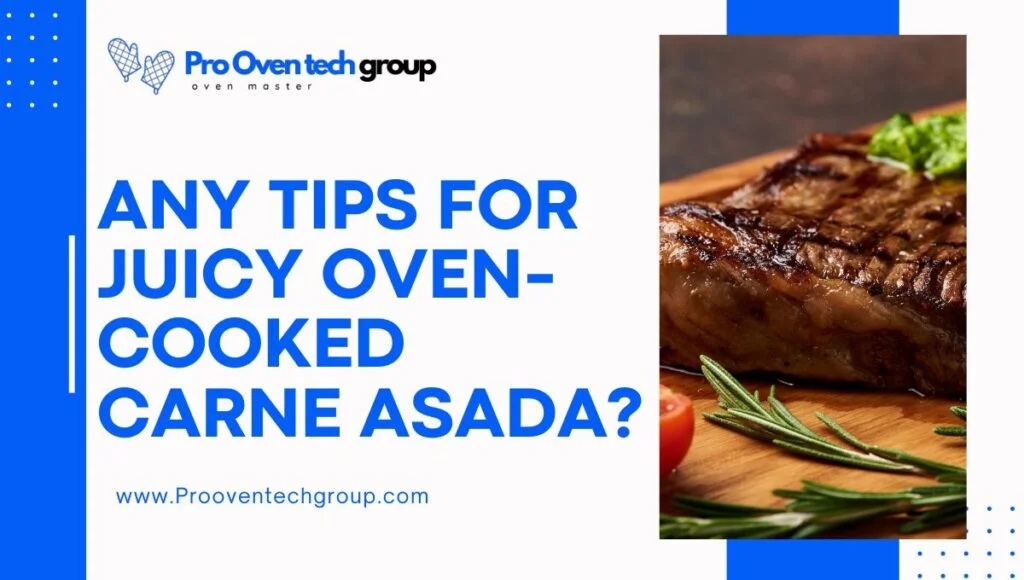how do you cook carne asada in the oven? Carne asada, a beloved dish with deep roots in Latin American cuisine, brings a fiesta of flavors to your dining table. Traditionally grilled over an open flame, this marinated beef is known for its rich, robust flavors and tender texture. It’s a versatile dish that can be served as a main course or used as a filling for tacos, burritos, and salads.
Interestingly, you can achieve deliciously marinated and tenderly cooked carne asada in the oven. By marinating it in a blend of citrus, garlic, and traditional spices, then broiling it to perfection, you bring outdoor flavors indoors with ease.
This alternative method does not only cater to those without access to a grill but also promises a year-round delight regardless of the weather. Thus, the oven-baked approach to carne asada not only preserves the dish’s signature charred exterior and juicy interior but also introduces a convenient and adaptable cooking technique.
Table of Contents
What ingredients are needed for oven-cooked carne asada?

The essential ingredients for oven-cooked carne asada include flank or skirt steak, orange and lime juice, garlic, cilantro, jalapeño, white vinegar, soy sauce, and a blend of spices such as cumin, chili powder, salt, and pepper. These components work together to marinate and infuse the meat with traditional flavors.
Citrus and Herbs
Citrus juices from oranges and limes, combined with fresh cilantro, not only tenderize the meat but also impart a vibrant, tangy flavor that is characteristic of traditional carne asada. These ingredients are the heart of the marinade, offering a refreshing zest.
Spices and Seasonings
The mix of cumin, chili powder, salt, and pepper provides the carne asada with its distinctive warm, earthy undertones and a hint of spice. These seasonings are essential for replicating the authentic taste of this Latin American dish.
Marinating Process
Allowing the meat to marinate in this flavorful blend for at least 1-4 hours, preferably overnight, ensures that the steak absorbs all the wonderful flavors, leading to a more tender and juicy result once cooked. This step is crucial for achieving the desired depth of flavor in your oven-cooked carne asada.
How to prepare the carne asada for oven cooking?
To prepare carne asada for oven cooking, begin by marinating your meat. This process infuses the steak with a lush blend of flavors, ensuring every bite is as tantalizing as the last. The preparation is simple but crucial for achieving that authentic taste and tenderness.
Step 1: Crafting the Marinade
Combine orange and lime juices, minced garlic, chopped cilantro, diced jalapeño, white vinegar, soy sauce, cumin, chili powder, salt, and pepper in a bowl. Whisk them together to blend the flavors.
Step 2: Marinating the Steak
Place your flank or skirt steak in a large resealable bag. Pour the marinade over the steak, ensuring it is fully coated. Seal the bag, then massage the marinade into the meat. Refrigerate for at least 1 hour, ideally overnight.
Step 3: Prepping for the Oven
Preheat your oven’s broiler. Remove the steak from the marinade, letting excess drip off. Place the steak on a broiler pan lined with aluminum foil for easy cleanup. Discard the remaining marinade.
Step 4: Broiling to Perfection
Broil the steak about 5-7 minutes on each side for medium-rare, depending on thickness. Use a meat thermometer to ensure it reaches the perfect temperature. Allow it to rest for a few minutes before slicing against the grain to serve.
What temperature should the oven be set to?
- Preheat Your Broiler: For the perfect carne asada, preheat your oven’s broiler. This high-temperature setting mimics the intense heat of grilling, giving your steak a beautiful char and locking in those juicy flavors.
- No Specific Temperature: Unlike baking, broiling doesn’t require a specific temperature setting. Your oven’s broiler function works by providing consistent, direct heat from the top element. Just ensure your rack is placed appropriately close to this element.
- Adjust Rack Position: Typically, setting your oven rack about 4 to 6 inches from the broiler element achieves the best results. This position allows for even cooking and a delightful char without burning your precious carne asada.
- Keep a Close Eye: Due to the high heat, carne asada cooks quickly under the broiler. It’s essential to monitor the cooking process closely, flipping the steak halfway through to ensure an evenly cooked, succulent meal.
- Broiling Time Variability: Since ovens and steak thicknesses vary, cooking times can differ. Starting with a preheated broiler, anticipate roughly 5-7 minutes per side for medium-rare, adjusting as necessary for your preferred doneness.
How long does carne asada need to cook in the oven?
The cooking time for oven-broiled carne asada varies depending on personal preferences for doneness and the thickness of the meat. Generally, it takes about 10-14 minutes total, flipping halfway through.
Checking for Doneness
- Use a meat thermometer for accurate results.
- Medium-rare typically reaches 135°F (57°C) internally.
- Leave steak for a few minutes before slicing.
- Slicing against the grain ensures tenderness.
- Resting meat locks in flavorful juices.
Adjusting Cooking Time
- Thicker cuts require longer broiling times.
- For well-done, extend each side’s broiling time.
- Keep oven door slightly ajar to monitor.
- Flipping halfway ensures even cooking and char.
- Experiment to find your perfect doneness level.
Serving Suggestions
- Pair with fresh, tangy salsa or guacamole.
- Chop for burritos or tacos for versatility.
- Serve with rice and beans for traditional meal.
- Leftovers make great salad or wrap fillings.
- Drizzle lime for an extra zesty flavor kick.
Do you need to flip the carne asada while cooking?
Yes, flipping carne asada during the cooking process is essential. This ensures the meat cooks evenly on both sides, achieving a perfect char and juiciness throughout.
- Ensure even cooking and browning on both sides.
- Flipping increases flavor by evenly distributing juices.
- Prevents burning and sticking to the broiler pan.
- Helps achieve a desirable crust on the steak.
- Promotes uniform doneness without overcooking edges.
- Allows for direct heat interaction with all surfaces.
- Enables better temperature control throughout cooking.
- Enhances the overall texture and taste of the meat.
Flipping carne asada while broiling is key for even cooking and perfect texture. This simple step ensures every bite is as delicious as possible.
Any tips for juicy oven-cooked carne asada?

- Marinate for Maximum Flavor: The secret to juicy carne asada lies in the marinade. A long marinating time not only infuses the steak with flavor but also tenderizes it. Aim for at least 4 hours, but overnight is best for the most flavorful and juicy outcome.
- Room-Temperature Steak: Before broiling, take your steak out of the fridge and allow it to come to room temperature for about 20-30 minutes. This helps in cooking the meat more evenly, ensuring that the inside is as juicy and tender as the outside.
- Don’t Skip Resting Time: After broiling, give your steak a good rest, tented with foil, for about 5-10 minutes. This allows the juices to redistribute throughout the meat, ensuring that each slice is dripping with flavorful juices.
- Use a Meat Thermometer: To avoid overcooking, which can lead to dryness, use a meat thermometer to check for doneness. For a juicy medium-rare finish, aim for an internal temperature of 135°F (57°C), then allow it to rest as it will continue to cook slightly.
- Slice It Right: The way you slice your carne asada can make a world of difference in texture. Always slice against the grain, which means cutting across the muscle fibers. This shortens them, making the meat incredibly tender and easy to chew.
Conclusion how do you cook carne asada in the oven
Creating the perfect oven-cooked carne asada is more art than science, blending techniques for marinating, broiling, and resting to ensure every slice is tender and bursting with flavor. By following these steps and tips, you can bring a piece of the traditional culinary experience into your own kitchen, impressing guests and satisfying all your carne asada cravings.
Whether you’re serving it up in tacos, burritos, or just alongside a simple salad, the key to a memorable carne asada lies in attention to detail—marinate well, cook carefully, and slice properly. Enjoy the rich flavors and the satisfaction of mastering this beloved dish, ready to be the highlight of any meal.
FAQS
Q1. How to cook thin sliced carne asada in the oven?
A1. The broiling method is perfect for thin slices of carne asada. Simply follow the same steps mentioned above, but keep a close eye on the cooking time as thinner cuts will cook much faster.
Q2. How to cook carne asada in a pan?
A2. To cook carne asada in a pan, heat a cast-iron skillet over high heat and cook the steak for about 3-4 minutes on each side for medium-rare. Remember to let it rest before slicing.
Q3. How long to cook carne asada in the oven?
A3. As mentioned earlier, the cooking time for oven-broiled carne asada varies depending on personal preferences and thickness. Aim for 5-7 minutes per side for medium-rare, adjusting as necessary.
Q4. How to cook marinated carne asada on the stove?
A4. Marinated carne asada can be cooked on the stovetop using a grill pan or cast-iron skillet. Simply heat the pan over medium-high heat, cook for 3-4 minutes on each side, and let it rest before slicing.
Q5. How do you cook carne asada in the oven easy?
A5. The easiest way to cook carne asada in the oven is by using the broiling method mentioned above. It requires minimal prep and cooking time, making it a quick and easy dinner option. Remember to flip the steak halfway through for even cooking.

